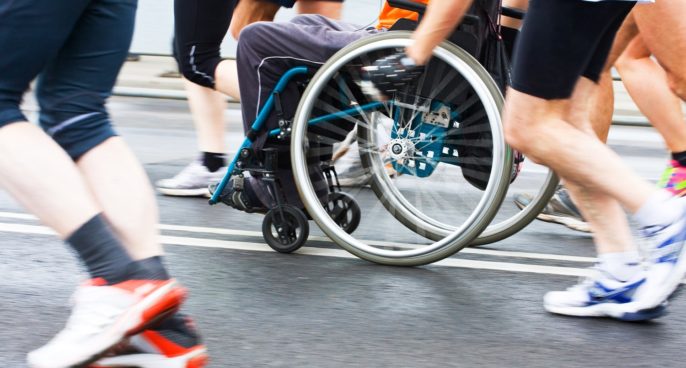
Are you hosting an event or planning a new project? Whether it’s a cultural festival, sporting event, wedding occasion or construction site, it’s your responsibility to ensure that visitors, customers, employees and volunteers are able to access the appropriate facilities while under your care. What’s more, those facilities must be accessible to everyone, regardless of age, medical condition or disability. So need hiring a disabled toilet.
With that in mind, it’s important that you take the appropriate steps with regard to planning all aspects of your project. This will likely entail the hiring of portable toilets, especially if your event is taking place in a remote location or on a site with no existing facilities available.
If that’s the case, you’ll also need to factor in the needs of your disabled, elderly or otherwise vulnerable guests. Equality, accessibility and social inclusion must figure prominently in your thinking when it comes to making the necessary arrangements.
Fortunately, there are a range of disabled and accessible toilets available for rental and purchase nowadays, including the top-of-the-range facilities and services provided by LetLoos. If you’re in the market for such facilities but aren’t sure about the ins and outs of acquiring them, this handy guide should tell you everything you need to know about disabled portable toilet hire.
Table of Contents
What the laws says
First and foremost, it’s now a legal requirement that you ensure that you provide adequate facilities for anyone who attends your site, whether that be in a visiting, working, volunteering or any other capacity.
The introduction of the Equality Act in 2010 means that it is illegal for any service provider to discriminate against or treat unequally any disabled person for the mere fact that they are disabled. This legislation was expanded upon by revisions to the Approved Document M in 2015 and 2016, which relates to the access to and use of new buildings or existing non-domestic buildings undergoing an extension. If you’re overseeing a festival situation or organising a new construction site workplace, both of these pieces of legislation are likely to apply to you.
The law stipulates that the person or persons responsible for the premises in question must make “reasonable adjustments” to the provisions, criteria, practices, physical features and auxiliary aid onsite to ensure that disabled people are not disadvantaged in comparison to persons who are not disabled.
Aside from any legal obligation, however, it’s simply a matter of decency to ensure that all-comers to your site are treated with equal respect and opportunity. Access to adequate sanitation facilities is a basic human right, albeit one that is unfortunately often overlooked. Any event organiser or project manager should be mindful of making sure they are as inclusive and as understanding as possible when it comes to putting the relevant arrangements in place.
What are “reasonable adjustments”?
The exact definition of “reasonable adjustments” is a fluid one subject to change over time and in relation to the type of situation involved. For that reason, it’s a good idea to investigate that particular term and its possible interpretations in a little more detail. While the term itself is somewhat subjective and can vary from case to case, it can generally involve the following concepts:
- Investigating the full spectrum of needs and requirements that may be demanded by a wide a range of different people suffering from different learning difficulties, disabilities or other ailments. In essence, this means not just seeking to comply with the bare minimum that the law demands, but going above and beyond to satisfy the needs of every visitor, volunteer or employee on your site.
- Undertaking and completing a full audit of your toilet facilities, as opposed to simply measuring them against the minimum standards required of you.
- Engaging with and listening to the concerns, opinions and advice of disabled staff, volunteers, customers or visitors, as well as the various organisations which represent them, to ensure you are offering the appropriate sanitation facilities to meet their needs.
- Making tangible adjustments to the facilities already in place on your site in order to accommodate those with mobility difficulties or other disabilities, or else constructing a new toilet block altogether to meet the shortfall.
- Providing fully-equipped Changing Places toilets on your premises, or else engaging disabled toilet rental services from a professional company to meet the shortfall.
- Publishing the relevant documentation relating to your facilities in order to keep all-comers to your site aware of what they can expect to experience when under your care.
- This documentation should include the relevant specifications of your facilities, including the width of the door openings, the height of the toilets themselves, the type of lighting infrastructure and the presence of handrails, etc.
The above list is by no means a comprehensive breakdown of everything that is required from you, but it does provide a good starting place to work from when planning your strategy. It must be remembered that the term “reasonable adjustments” is open to interpretation, so it’s advisable for site owners or project managers to keep abreast of how the term is being interpreted in courts of law and in the Equality Act of 2010 in order to avoid falling foul of the legislation.
It should be noted, however, that ignorance of the rules will not be tolerated as an excuse for non-compliance. Similarly, arguing that the incorporation of accessible toilets on your site is “too expensive” or “too disruptive” will also not wash in a court of law, since these costs and timing should have been factored into your original business proposal. It is your duty to plan ahead and account for every eventuality, rather than simply wait for a disabled person to run into difficulties on your property and plead innocence or ignorance thereafter.
What makes a toilet accessible?
Now that you’re a little more familiar with what the legal requirements of hiring a disabled toilet are, it’s important to recognise what specific features qualify a toilet as an accessible one. The exact specifications of the toilet will vary depending upon the supplier you use, the situation in which the item is being employed and the needs of the community that it must serve, but accessible toilets all share the same basic credentials:
Dimensions
While the exact dimensions of a disabled toilet do differ between models, a basic trait shared among all of them is the enlarged size of the facilities. The recommended minimum size of a unit is 2,200mm x 1,500mm, which allows plenty of room for a wheelchair to enter the room.
It should also be remembered that many disabled persons require the help of one or more carers to move them onto the toilet seat and allow them to use the facilities. That demands plenty of elbow room in which to manoeuvre – something which is not always provided for in disabled toilets, especially when items which may project into the room (such as waste disposal units, baby changing facilities or radiators) are taken into account
Grab rails
The presence of handrails and grab rails are absolutely essential in a disabled toilet. These provide the stability and assistance that those with reduced mobility require to help them safely and easily manoeuvre around the toilet. Not only do they facilitate the process for many users, but they’re also a matter of health and safety, reducing the likelihood of accident and injury.
Grab rails can take the form of stowaway rails at both sides of the toilet unit, which can be folded up and stored when not in use. Alternatively, they can also take the form of permanent fixtures bolted to the wall. Whichever form they take, they must be robust and reliable, capable of supporting the entire weight of an adult.
Intuitive and easy-to-use features
Given that disabled individuals may suffer from any number of muscle movement limitations, the features of a disabled toilet must take these into account. For example, the toilet itself should employ a flush paddle that can be depressed without too much force being exerted upon it, so that those incapable of pressing down too hard are accommodated.
Meanwhile, the handwashing facilities must be designed with the needs of a disabled person in mind. This means that the taps should have easy grips and minimal resistance when turning off and on, while the soap dispenser must be intuitive and easy-to-use. Ideally, one which is triggered by either motion or heat beneath it will be in place, since this type of device can be easily used by everyone.
Doors
The doors themselves must be adapted to cater to the unique conditions and circumstances in which they will be used. For starters, this means a doorway opening which is wide enough to allow a wheelchair to pass through it comfortably, since many disabled users depend upon a wheelchair to get around.
Secondly, the opening and closing of the door must not pose a problem. When investigating disabled toilet hire, make sure you opt for one which open outwards rather than inwards (allowing more room inside the cubicle itself), as well as a toilet which incorporates easy-to-use features such as a large horizontal bar on the inside of the door that can be pushed open with the minimum of effort.
Height of fixtures
The height of the fixtures and fittings inside the toilet unit must necessarily be lower than those in a standard portable toilet, since people in a wheelchair must be able to easily access the toilet itself, the sink, the soap dispenser and other features within the cubicle.
In an ideal world, the fixtures will actually be height adjustable, allowing users (and their carers) to tailor the layout of the toilet to the requirements of those who need them on a case-by-case basis. Of course, this may not always be possible – especially when it comes to disabled portable toilet hire – but making the necessary adjustments to accommodate those with different needs is a minimum requirement.
Alarm system
Finally, all disabled toilets must be equipped with a functional alarm system. This is to ensure that even if a user suffers an accident, encounters an emergency or requires help from outside the toilet unit for some other reason, they are able to alert others as to their predicament quickly and easily.
An alarm system is most commonly triggered by a hanging red cord by the toilet bowl. The cord should be clearly marked as an emergency alarm (so it’s not mistaken for the flush by users) and should be left dangling within easy reach of anyone sitting on the toilet bowl. It should never be tied up out of reach, even if this appears to be a more visually pleasing manner of storing it.
Different types of disabled toilets
While all accessible toilets should contain the features laid out above in some form or other, not all accessible toilets are created equal. Indeed, there are several varieties of accessible toilets of which you should be aware, including the following:
“Accessible toilets” or “adaptable toilets”
These toilets are designated for use by ambulant disabled people, which means those who can still move around but require the use of crutches, a Zimmer frame or other support device with which they facilitate their mobility.
This type of toilet can be incorporated into a standard toilet block, but can also take the form of a single cubicle. It is generally only single-gender use and looks much like a standard toilet cubicle, although it must have support rails in place to allow an ambulant disabled person to support themselves during use. It is also generally larger in its dimensions than a standard cubicle.
According to Approved Document M, each single-gender toilet block must contain at least one ambulant disabled toilet. The sign for this type of toilet generally portrays a figure with one or more sticks or crutches to support themselves.
“Wheelchair accessible toilets”
This type of toilet is perhaps the one which instantly springs to mind when envisioning a disabled toilet. It is appropriate for use by persons suffering from all kinds of disability, including but not limited to those in a wheelchair. It also accommodates those with limited mobility, sensory impairments, mental health issues, short stature or any other medical condition which demands the presence of an emergency alarm system inside the toilet cubicle.
Wheelchair accessible toilets can either be contained within single-gender toilet blocks, or else as standalone unisex cubicles. Approved Document M dictates that site owners or project managers must provide at least one unisex toilet in addition to separate gender bathrooms in any building where sanitation facilities are provided for visitors, customers, workers and volunteers.
The exact layout and features of each wheelchair accessible toilet may vary, but all must comply with the guidelines and legislation mentioned above. This type of toilet is indicated by the wheelchair symbol. All of the disabled toilets available for hire at LetLoos fall under this particular category of accessible toilet.
“Changing Places toilets”
This type of toilet is specifically designated for use by those who require additional space, a hoist to manoeuvre into position, a changing bench and special hygiene facilities. This latter point may include an adjustable toilet and/or sink, shower units and automated washing and drying fixtures.
Changing Places toilets are mentioned in Approved Document M as being appropriate for larger building developments. They are also recommended in the British Standard 8300, introduced in 2009, while they are included in the government’s published materials on “Improving Public Access to Better Quality Toilets”, as well.
The sign for a Changing Places toilet depicts a wheelchair user alongside a carer standing behind a bench, while a hoist hangs down from the ceiling. They are appropriate for use by those with profound learning difficulties and/or mental disabilities, as well as individuals suffering from spinal cord injuries, muscular dystrophy, multiple sclerosis or any other serious physical complication.
Baby changing
Although not directly connected to the needs of disabled toilet users, parents and guardians of babies and other young children also require a specific type of facility. While this is not demanded by legislation, accommodating for this section of society can make your site more attractive to visitors and customers and more pleasant to be in for workers and volunteers.
Like disabled toilets, baby changing facilities require more room to manoeuvre than standard toilets. They also demand a fold-down table or other flat surface upon which the baby can be laid while their parent or guardian busies themselves with the process of changing their clothes. The expansive dimensions of a disabled toilet make for a great place to incorporate such facilities, effectively satisfying the needs of two very different segments of society with one product.
At LetLoos, we’re aware of this overlap between the needs of disabled persons and those caring for babies. That’s why all of the accessible toilet units which we provide come equipped with the appropriate fittings and fixtures. As well as the aforementioned surface, this also includes a sanitary bin in which to dispose of soiled nappies, adequate soap dispensing facilities and motion-activated LED lights, ensuring a clean, hygienic and well-lit environment in which to look after a baby.
An events checklist for disabled access
Hiring a disabled toilet for your venue is a huge step in the right direction towards making it accessible and inclusive for all visitors, customers, workers and volunteers. However, it’s not the only consideration that should be taken into account for those organising an event or supervising a project. This handy checklist should give you an insight into other areas of concern that you should consider:
Publicity, marketing and instructional materials
- Have you made information about the accessibility of your site or venue publicly available, either in print, online or at the venue itself?
- Is the information available in alternative formats for those who may suffer from specific disabilities, such as large print, braille, easy read or plain English?
- Have you publicised the availability of these alternative formats?
Travel to and from the venue
- Are there accessible parking bays available, and are these clearly signposted?
- Are these bays appropriate for use by minivans, people carriers and other larger vehicles?
- Are these parking bays publicised in your marketing materials, promotional information or employee instructional guides?
- Have you made information on public transport routes and nearby taxi services publicly available?
- Have you indicated the distances and gradients between key points of your site in a manner that is easy to understand?
- Where are the drop-off and pick-up points for visitors, customers, employees and volunteers at your site? Are these points clearly signposted?
Signage and orientation
- Is there someone who is designated to meet and greet all visitors, customers, employees and volunteers to your site? Are they easily spotted?
- Is there clear signage in place throughout your site?
- Have those signs been placed at a height that is easily readable by wheelchair users?
- Are there reflective surfaces or other distracting elements which may make it difficult to read the signage?
- Is the signage written and illustrated in fonts, colours, language and symbols that are easily intelligible to everyone who sees it?
- Are all entrances and exits clearly signposted?
- Are all stairways and ramps indicated with high-contrast signage?
Site layout
- Have you factored in the needs of disabled persons when designing the layout of your site?
- Is there appropriate turning room for wheelchairs, pushchairs and prams (minimum 1,300mm)?
- Is there adequate lighting in place throughout your site?
- Are all access routes across the site level and free from obstacles or other obstructions?
- Is there seating space available for those in a wheelchair that is not segregated from non-wheelchair users (including their friends, family or carers)?
- Does your seating have appropriate cushions and armrests to facilitate mobility and create a better user experience?
Other considerations
- Have you thought carefully about the timing of the event?
- Are there visual and oral announcements for emergency situations or to impart important information to attendees?
- Are you providing any additional services such as wheelchair, buggy or scooter hire, water bowls for guide dogs or induction loops?
Call in the professionals
The above guide should give you a solid grounding for planning for the needs of all comers to your venue or site, making it socially inclusive for everyone. While it’s not the only piece of the puzzle, disabled portable toilet hire is a key component of ensuring your event or project achieves its full potential.
At LetLoos, we offer disabled toilet rental to ensure you fulfil both your legal and social responsibilities with regard to anyone visiting, working at or volunteering for your site. We deliver our units in pristine condition and ensure that they are properly and safely installed onsite. For longer jobs, we can provide exemplary cleaning and maintenance services, while we’ll also collect the unit once its presence is no longer required.
The whole process revolves around just four steps. You can get the ball rolling by getting in touch with the friendly team of experienced professionals at LetLoos. After an initial consultation and free, no-obligation quote, it’s simply a case of delivering the toilet to your location and setting it up for use. And voila! You’ll be up and running with regard to the provision of disabled toilets on your site. Don’t delay – get in contact with our team today. We’re waiting to take your call.



